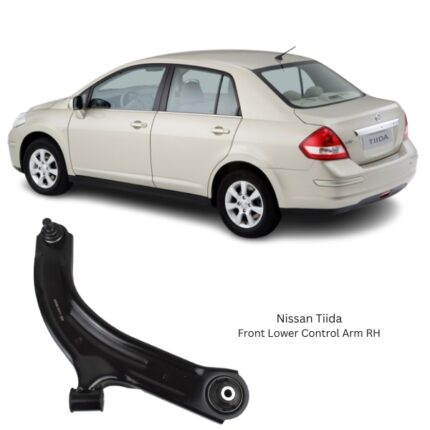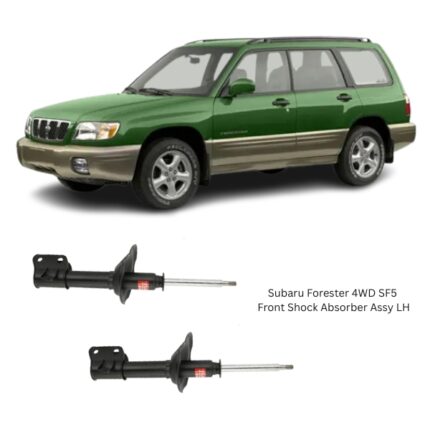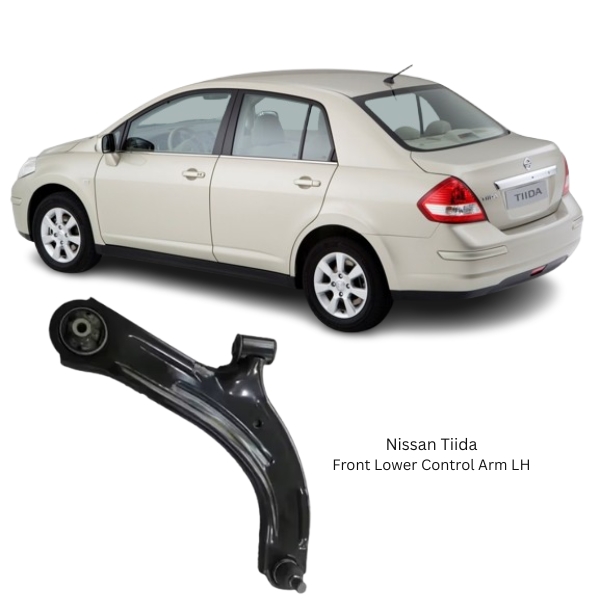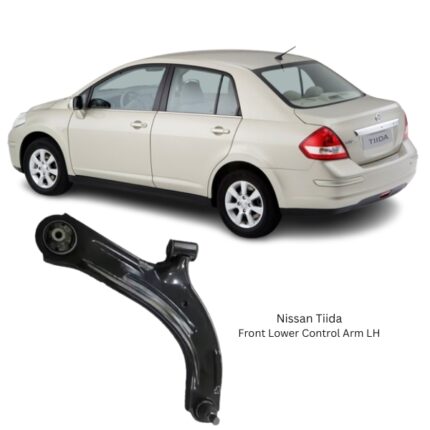Get Nissan Tiida Front Lower Control Arm LH 54501-ED000 in Kenya
The front lower control arm LH is an integral component of the front suspension system, engineered to provide structural support and dynamic stability for the vehicle’s left-hand (driver’s) side front wheel assembly. This component connects the suspension of the vehicle to the chassis, allowing the front wheels to move up and down in response to road conditions while keeping the wheels aligned and controlled during driving, braking, and cornering.
Designed for both comfort and safety, the control arm ensures consistent handling characteristics and suspension geometry under varying road conditions. Its performance directly influences steering precision, vehicle balance, and tire wear.
Function and Purpose
The primary role of the front lower control arm LH is to serve as a pivoting link between the wheel hub or steering knuckle and the vehicle’s frame or subframe. It allows vertical movement of the suspension while resisting lateral and longitudinal forces. The control arm’s design enables the wheel to maintain contact with the road surface during cornering, braking, and uneven terrain traversal.
Key functions include:
-
Suspension Articulation: It allows the wheel to travel vertically with minimal resistance while maintaining its position relative to the chassis.
-
Load Bearing: It supports vertical loads from the weight of the vehicle and dynamic forces from braking and acceleration.
-
Wheel Alignment Maintenance: It helps retain proper camber and caster angles, ensuring optimal tire contact with the road.
-
Stability and Steering Control: It contributes to accurate steering response and minimizes body roll.
Without a functioning control arm, the front suspension cannot maintain its shape or performance, leading to reduced road safety and comfort.
Design and Construction
Control arms are engineered for strength, durability, and precision. The LH (left-hand) control arm is specifically designed to mount on the left side of the vehicle and is not interchangeable with the RH (right-hand) version due to variations in mounting geometry and structure.
Common construction materials include:
-
Stamped Steel: Known for strength and cost-effectiveness.
-
Forged Aluminum: Offers lighter weight and corrosion resistance.
-
Cast Iron or Steel: Often used in heavier-duty applications for durability under extreme stress.
The standard design resembles an A-shape or wishbone, though variations exist depending on suspension architecture. The control arm has three major connection points:
-
Chassis Mounts: Featuring bushings, these are bolted to the vehicle’s frame.
-
Ball Joint Connection: Joins the control arm to the steering knuckle and allows pivoting motion.
-
Stabilizer Bar or Link Mounts (where applicable): For further control of body movement and roll.
Bushings and Ball Joint Integration
Two vital subcomponents of the control arm are:
1. Control Arm Bushings
Located at the frame-side mounting points, these are typically made of rubber, polyurethane, or synthetic elastomers. Their functions include:
-
Damping road vibrations before they reach the chassis.
-
Allowing the arm to pivot smoothly.
-
Reducing metal-to-metal contact, which protects other suspension parts.
Signs of bushing wear include clunking noises, poor handling, or visible cracking.
2. Ball Joint
Located at the wheel-side end, the ball joint provides articulation between the steering knuckle and control arm. It allows both vertical suspension movement and horizontal steering movement.
Ball joints may be:
-
Integrated: Permanently fixed into the control arm.
-
Serviceable: Bolted or pressed in and replaceable separately.
A worn ball joint can result in loose steering, excessive play, and uneven tire wear.
Side Specificity: Importance of LH Fitment
The Left-Hand (LH) control arm is manufactured specifically for the driver’s side of the vehicle (for left-hand drive regions). It is uniquely angled and shaped to account for:
-
Suspension geometry
-
Brake caliper clearance
-
Strut and sway bar mounting orientation
-
Steering system interaction
Installing the incorrect side can lead to improper wheel alignment, compromised handling, and potential safety risks.
Signs of a Failing Front Lower Control Arm
The control arm is subjected to constant stress and wear over time. Key symptoms of a failing LH front lower control arm include:
-
Knocking or Clunking Noises: Often heard during turns or when going over bumps.
-
Steering Instability: Loose or unresponsive steering can indicate bushing or ball joint wear.
-
Excessive Vibration: Especially noticeable through the steering wheel at certain speeds.
-
Uneven Tire Wear: Misalignment caused by a faulty control arm leads to premature tire degradation.
-
Vehicle Pulling: The vehicle may drift to one side while driving or braking.
-
Visible Damage: Bent arms, torn bushings, or leaking ball joints upon inspection.
Prompt replacement is crucial to avoid further suspension damage or unsafe driving conditions.
Installation and Replacement
Replacing the front lower control arm LH is a moderately technical procedure typically performed using the following steps:
-
Lift the Vehicle: Safely raise and support the vehicle on jack stands.
-
Remove the Wheel: Expose the suspension and steering components.
-
Disconnect the Ball Joint: Usually via a cotter pin and castle nut. Use a separator tool if necessary.
-
Unbolt the Control Arm: Remove bolts at the chassis mount and sway bar link (if applicable).
-
Install the New Arm: Align it properly, insert the bushings, and torque fasteners to specification.
-
Reconnect the Ball Joint and Components: Reassemble everything in reverse order.
-
Check Alignment: A wheel alignment is strongly recommended to restore proper suspension geometry.
Professional installation ensures correct torque values and alignment, which are critical for safety and performance.
Maintenance Tips
To maximize the lifespan of the front lower control arm LH:
-
Inspect Regularly: During tire rotations or oil changes, check for visible damage or bushing wear.
-
Clean After Off-Road Driving: Dirt and debris can accelerate corrosion or damage bushings.
-
Replace in Pairs: For balanced suspension performance, consider replacing both LH and RH arms together.
-
Check Alignment Annually: Misalignment can indicate early control arm wear or suspension issues.
-
Lubricate Serviceable Ball Joints: If applicable, use the appropriate grease to prevent dry joint failure.
Follow us on Facebook for more parts.





Reviews
Clear filtersThere are no reviews yet.